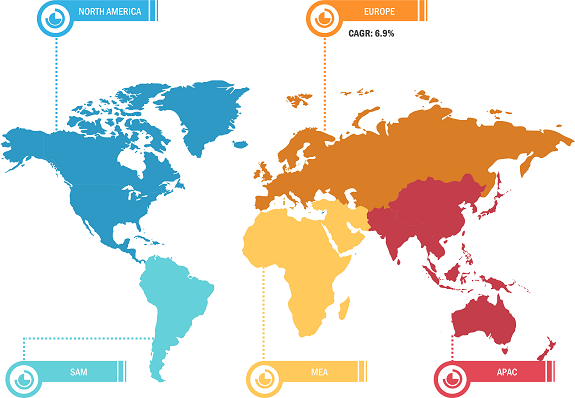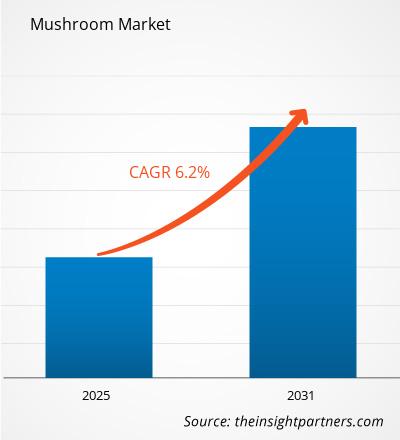キノコ市場規模は、2022 年の 136 億 7,000 万米ドルから 19.63 米ドルに成長すると予想されています2031年までに10億ドル。 2022 年から 2031 年にかけて 6.2% の CAGR を記録すると推定されています。
食用キノコは、数種類の大型菌類の多肉質で食用となる子実体です。キノコは主に中国、米国、オランダ、フランス、ポーランドで栽培されています。ホワイトマッシュルーム、クレミニマッシュルーム、シイタケ、ヒラタケ、エノキマッシュルーム、アンズタケ、ポルチーニマッシュルーム、ポートベッロマッシュルーム、ブラウンマッシュルームは、世界中で一般的に消費されているキノコの種類です。キノコにはセレンやグルタチオンなどの抗酸化物質も豊富に含まれています。さらに、ビタミン B と D、リン、マグネシウム、カルシウム、カリウムが高レベルで含まれています。
2021 年、アジア太平洋地域が最大のシェアを占めました。キノコ市場。ただし、ヨーロッパは予測期間中に最も高い CAGR を記録すると推定されています。この地域の市場の成長は、栄養豊富な食品の消費に対する消費者の傾向と、その抗生物質の特性によるキノコの医療用途の増加に起因すると考えられています。抗がん剤との相乗効果についても研究されています。キノコから抽出された化合物または物質は、免疫抑制剤、コレステロール阻害剤、向精神薬などに利用できます。アジア太平洋地域はキノコの最大の生産国であり、中国、日本、インド、タイ、フィリピン、インドネシアなどの国々がこの地域の生産量に主に貢献しています。キノコの生産を促進する政府の取り組みも、この地域の市場の成長に貢献しています。福州にあるアジア太平洋食用キノコトレーニングセンターは、研究研究、開発、国際的な技術トレーニングに熱心に取り組んでいます。また、食用キノコに関する交換、経済貿易協力にも取り組んでおり、食用キノコの産業化と国際化を促進しています。
戦略的洞察
キノコ市場に対する新型コロナウイルス感染症のパンデミックの影響
新型コロナウイルス感染症(COVID-19)のパンデミックによるロックダウンの発動、渡航制限、事業停止は、北米、欧州、アジア太平洋(APAC)、南米、南米のさまざまな国の経済と産業に悪影響を及ぼしました。中米 (SAM)、中東および中東アフリカ (MEA)。その後、社会的および商業的制限により、サプライチェーン、製造活動、配送スケジュール、必需品および不要品の販売に混乱が生じました。しかし、消費者の嗜好が高まったため、キノコの需要が増加しました。植物ベースの食品とキノコの健康上の利点に対する意識の高まり。このように、製造活動の停止と需要の増加により、需要と供給のギャップが生じました。 2021年、さまざまな企業がキノコの委託販売が遅れる可能性を発表し、将来の売上の低迷を予測した。さらに、ヨーロッパ、アジア太平洋、北米のさまざまな国の政府によって課された海外旅行の禁止により、いくつかの企業は協力および提携計画の中止を余儀なくされました。
地域別キノコ市場の内訳
< p> 市場洞察
市場洞察予測期間中にキノコ市場を牽引する主要企業による戦略的展開
製品の革新、工場の生産能力の拡大、合併と統合。買収は、キノコメーカーが市場での地位を強化し、顧客ベースを拡大するために実行する重要な戦略の1つです。たとえば、ビッグ マウンテン フーズは、腸内健康食品のリーダーであるスプラウツ ファーマーズ マーケットと提携し、初のライオンたてがみマッシュルーム製品ラインを北米全土で発売すると発表しました。したがって、市場関係者による継続的な戦略的開発は、予測期間中にキノコ市場に計り知れない機会を提供すると予想されます。
タイプ インサイト
キノコ市場は種類に基づいて、ボタンマッシュルーム、シイタケ、ヒラタケ、その他に分類されます。ボタンマッシュルームセグメントは2021年に最大の市場シェアを保持し、シイタケマッシュルームセグメントは2022年から2031年にかけて最高のCAGRを記録すると予想されています。ボタンマッシュルームは胞子の潜伏時間が短いため、主に世界中で栽培されているキノコです。さらに、ボタンマッシュルームは他の種類よりも低コストであり、多くの栄養上の利点があるため、このセグメントの市場成長に有利です。
キノコ市場、タイプ別 – 2022 年と 2031 年
 カテゴリの分析情報
カテゴリの分析情報
カテゴリーに基づいて、キノコ市場はオーガニックと従来型に分類されます。 2021年には従来型セグメントがより大きな市場シェアを保持しました。しかし、オーガニックセグメントは、予測期間中により高いCAGRを記録すると予測されています。さまざまなキノコが、化学肥料や農薬を使用して従来からさまざまな国で栽培されています。これらのカテゴリーでは遺伝子組み換え生物が使用されており、一貫した作物の収量が確保されています。しかし、その高品質と持続可能性によりオーガニック製品の人気が高まっているため、今後数年で従来の製品に対する好みが薄れる可能性があります。ただし、地元の食品製造業者は、手頃な価格と入手可能性を理由に、従来のキノコを使用し続ける可能性があります。
ジョルジオ フレッシュ カンパニー;株式会社ビーアンドジーフーズ;バンケン シャンピニオンズ BV;モントレーマッシュルームLLC;ウッドストック・フーズ。ボンデュエルSA;モナハン・グループ。ウォルシュキノコグループ;鍛冶キノコ;および Bluff City Fungi は、キノコ市場で活動する主要企業の 1 つです。これらの企業は、市場規模を拡大し、新興市場のトレンドを追うために、主に製品イノベーションに重点を置いています。このような製品は、予測期間中に消費者の間で大きな注目を集めると予想されます。
レポートのスポットライト
- 企業が効果的な長期戦略を策定するのに役立つ、キノコ市場における進歩的な業界トレンド
- 市場関係者が採用したビジネス成長戦略先進国と発展途上国
- 2022 年から 2031 年までの市場の定量分析
- キノコの世界的な需要の推定
- キノコ市場における買い手と供給者の有効性を示すポーターのファイブ フォース分析
- 競争市場シナリオを理解するための最近の動向
- 市場の傾向と見通し、市場の推進力と制約
- キノコ市場関係者の戦略を強調することで意思決定プロセスを支援
- さまざまなノードにおけるキノコ市場の規模
- 市場の詳細な概要と細分化、およびキノコ業界の動向
- 成長の可能性が期待できるさまざまな地域のキノコ市場の規模
- 過去2年間の分析、基準年、CAGRによる予測(7年間)
- PEST分析とSWOT分析
- 市場規模価値/数量 - 世界、地域、国
- 業界と競争環境
- Excel データセット



Report Coverage
Revenue forecast, Company Analysis, Industry landscape, Growth factors, and Trends

Segment Covered
This text is related
to segments covered.

Regional Scope
North America, Europe, Asia Pacific, Middle East & Africa, South & Central America

Country Scope
This text is related
to country scope.
よくある質問
Ans. The Asia Pacific region led the mushroom market with the highest market share in 2018. The continuous economic growth in developed and developing countries like India and China, coupled with the presence of huge disposable incomes with individuals in countries like Japan and Australia, has facilitated the rapid growth of the automotive industry in this region. China is the largest producer of mushrooms in the APAC region. The production in the region is mostly devoured by the change in eating habit of consumers and medicinal use of mushrooms since it includes antibiotics, anti-cancer drugs, cholesterol inhibitors, psychotropic drugs, an immunosuppressant. The Asia Pacific region is also the quickest increasing local market for mushrooms.
Ans. Growing demand for mushrooms is a major breakthrough in the food industry. Mushrooms have been used as food by mankind since time age-old times after collecting from the forests. However, mushrooms could not be domesticated due to its complex nature. Nevertheless, China was the first ones to do the artificial cultivation of the tropical and subtropical mushrooms about thousand years ago but the real commercial ventures started when the Europeans started cultivation in greenhouses and caves during 16th and 17th century.
Ans. The leading type of mushroom is the button mushroom that has noted to grow at a significant CAGR. Button Mushroom also known as table mushrooms, common mushrooms, Champignon de Paris, and Cultivated mushrooms is one of the most popular mushroom variety grown and consumed globally. Cultivation of button mushrooms was started in the sixteenth century by the Europeans. White button mushroom on a large scale is produced in central Europe (mainly western part), North America (USA, Canada) and S.E. Asia (China, Korea, Indonesia, Taiwan, and India). These white button mushrooms are traded as the fresh mushrooms for canning purposes and also is used to make soups, sauces and other food products. Protein in mushrooms is very high which helps for digestibility and contains all the essential amino acids. It also has medicinal properties, a high amount of retene is present in the button mushroom which is supposed to have an antagonistic effect on some forms of tumors. In Egypt, they were valued for the belief of giving the consumer special powers or eternal life. In France, the white button mushrooms were cultivated in the catacombs and White button mushrooms are still cultured underground in Western France today. In addition to cultural folklore, the mushrooms were used in traditional Chinese medicine to help regulate the body’s energy and to provide additional antioxidants to promote overall health and well-being.
Trends and growth analysis reports related to Food and Beverages : READ MORE..
The List of Companies
- CMP Mushrooms
- Costa Group
- Gourmet Mushrooms, Inc.
- Monterey Mushrooms, Inc.
- The Mushroom Company
- Monaghan Mushrooms
- Okechamp SA
- Scelta Mushrooms B.V.
- Greenyard
- Giorgio Fresh Co.
The Insight Partners performs research in 4 major stages: Data Collection & Secondary Research, Primary Research, Data Analysis and Data Triangulation & Final Review.
- Data Collection and Secondary Research:
As a market research and consulting firm operating from a decade, we have published and advised several client across the globe. First step for any study will start with an assessment of currently available data and insights from existing reports. Further, historical and current market information is collected from Investor Presentations, Annual Reports, SEC Filings, etc., and other information related to company’s performance and market positioning are gathered from Paid Databases (Factiva, Hoovers, and Reuters) and various other publications available in public domain.
Several associations trade associates, technical forums, institutes, societies and organization are accessed to gain technical as well as market related insights through their publications such as research papers, blogs and press releases related to the studies are referred to get cues about the market. Further, white papers, journals, magazines, and other news articles published in last 3 years are scrutinized and analyzed to understand the current market trends.
- Primary Research:
The primarily interview analysis comprise of data obtained from industry participants interview and answers to survey questions gathered by in-house primary team.
For primary research, interviews are conducted with industry experts/CEOs/Marketing Managers/VPs/Subject Matter Experts from both demand and supply side to get a 360-degree view of the market. The primary team conducts several interviews based on the complexity of the markets to understand the various market trends and dynamics which makes research more credible and precise.
A typical research interview fulfils the following functions:
- Provides first-hand information on the market size, market trends, growth trends, competitive landscape, and outlook
- Validates and strengthens in-house secondary research findings
- Develops the analysis team’s expertise and market understanding
Primary research involves email interactions and telephone interviews for each market, category, segment, and sub-segment across geographies. The participants who typically take part in such a process include, but are not limited to:
- Industry participants: VPs, business development managers, market intelligence managers and national sales managers
- Outside experts: Valuation experts, research analysts and key opinion leaders specializing in the electronics and semiconductor industry.
Below is the breakup of our primary respondents by company, designation, and region:

Once we receive the confirmation from primary research sources or primary respondents, we finalize the base year market estimation and forecast the data as per the macroeconomic and microeconomic factors assessed during data collection.
- Data Analysis:
Once data is validated through both secondary as well as primary respondents, we finalize the market estimations by hypothesis formulation and factor analysis at regional and country level.
- Macro-Economic Factor Analysis:
We analyse macroeconomic indicators such the gross domestic product (GDP), increase in the demand for goods and services across industries, technological advancement, regional economic growth, governmental policies, the influence of COVID-19, PEST analysis, and other aspects. This analysis aids in setting benchmarks for various nations/regions and approximating market splits. Additionally, the general trend of the aforementioned components aid in determining the market's development possibilities.
- Country Level Data:
Various factors that are especially aligned to the country are taken into account to determine the market size for a certain area and country, including the presence of vendors, such as headquarters and offices, the country's GDP, demand patterns, and industry growth. To comprehend the market dynamics for the nation, a number of growth variables, inhibitors, application areas, and current market trends are researched. The aforementioned elements aid in determining the country's overall market's growth potential.
- Company Profile:
The “Table of Contents” is formulated by listing and analyzing more than 25 - 30 companies operating in the market ecosystem across geographies. However, we profile only 10 companies as a standard practice in our syndicate reports. These 10 companies comprise leading, emerging, and regional players. Nonetheless, our analysis is not restricted to the 10 listed companies, we also analyze other companies present in the market to develop a holistic view and understand the prevailing trends. The “Company Profiles” section in the report covers key facts, business description, products & services, financial information, SWOT analysis, and key developments. The financial information presented is extracted from the annual reports and official documents of the publicly listed companies. Upon collecting the information for the sections of respective companies, we verify them via various primary sources and then compile the data in respective company profiles. The company level information helps us in deriving the base number as well as in forecasting the market size.
- Developing Base Number:
Aggregation of sales statistics (2020-2022) and macro-economic factor, and other secondary and primary research insights are utilized to arrive at base number and related market shares for 2022. The data gaps are identified in this step and relevant market data is analyzed, collected from paid primary interviews or databases. On finalizing the base year market size, forecasts are developed on the basis of macro-economic, industry and market growth factors and company level analysis.
- Data Triangulation and Final Review:
The market findings and base year market size calculations are validated from supply as well as demand side. Demand side validations are based on macro-economic factor analysis and benchmarks for respective regions and countries. In case of supply side validations, revenues of major companies are estimated (in case not available) based on industry benchmark, approximate number of employees, product portfolio, and primary interviews revenues are gathered. Further revenue from target product/service segment is assessed to avoid overshooting of market statistics. In case of heavy deviations between supply and demand side values, all thes steps are repeated to achieve synchronization.
We follow an iterative model, wherein we share our research findings with Subject Matter Experts (SME’s) and Key Opinion Leaders (KOLs) until consensus view of the market is not formulated – this model negates any drastic deviation in the opinions of experts. Only validated and universally acceptable research findings are quoted in our reports.
We have important check points that we use to validate our research findings – which we call – data triangulation, where we validate the information, we generate from secondary sources with primary interviews and then we re-validate with our internal data bases and Subject matter experts. This comprehensive model enables us to deliver high quality, reliable data in shortest possible time.

 このレポートの無料サンプルを入手する
このレポートの無料サンプルを入手する